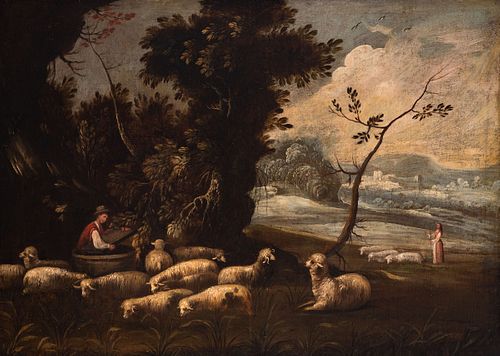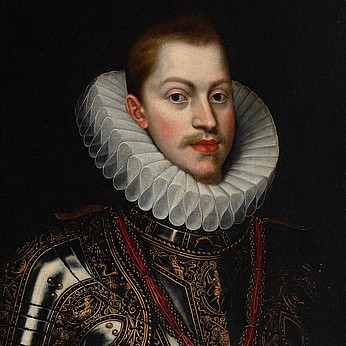Spanish school of the seventeenth century. Possibly FRANCISCO ANTOLÍNEZ Y SARABIA (Seville, around 1645 - Madrid, 1700) or IGNACIO DE IRIARTE (Azcotia
Lot 49
About Seller
Setdart Auction House
Carrer Aragó 346
Barcelona
Spain
Setdart Subastas was born in 2004 and is currently the first online art auction in Spain with solidity, prestige and reliability guaranteed by our more than 60,000 users. Setdart has a young, dynamic and enterprising team ready to successfully manage the purchase and sale of art works through custom...Read more
Estimate:
EUR€3,000 - EUR€3,500
$3,125 - $3,645.83
Absentee vs Live bid
Two ways to bid:
- Leave a max absentee bid and the platform will bid on your behalf up to your maximum bid during the live auction.
- Bid live during the auction and your bids will be submitted real-time to the auctioneer.
Bid Increments
| Price | Bid Increment |
|---|---|
| EUR€0 | EUR€10 |
| EUR€200 | EUR€25 |
| EUR€500 | EUR€50 |
| EUR€1,000 | EUR€100 |
| EUR€3,000 | EUR€200 |
| EUR€5,000 | EUR€500 |
| EUR€10,000 | EUR€1,000 |
| EUR€20,000 | EUR€2,000 |
| EUR€50,000 | EUR€5,000 |
About Auction
By Setdart Auction House
Nov 24, 2021
Set Reminder
2021-11-24 09:00:00
2021-11-24 09:00:00
America/New_York
Bidsquare
Bidsquare : Old Masters, Day 1
https://www.bidsquare.com/auctions/setdart-auction-house/old-masters-day-1-7873
Setdart Auction House sofia@setdart.com
Setdart Auction House sofia@setdart.com
- Lot Description
Spanish school of the seventeenth century. Possibly FRANCISCO ANTOLÍNEZ Y SARABIA (Seville, around 1645 - Madrid, 1700) or IGNACIO DE IRIARTE (Azcotia, 1620- Seville, 1685). "Pastoral scene". Oil on canvas. Frame with plaque of attribution to Francisco Antolínez. Measurements: 84 x 110 cm; 93 x 120 cm (frame). We are in front of a pastoral scene close to the works of Ignacio de Iriarte (Azcoitia, 1621 - Seville, 1670) and Francisco Antolínez Sarabia (Seville, around 1645 - Madrid, 1700), both painters ascribed to the Sevillian school of painting. It is a work in which the artist tries to communicate a religious reverence for the landscape, as well as for the figures that complete it: a shepherd resting while watching over his sheep and a young woman (in the background) leading her flock. Brother of the painter José Antolínez, Francisco was a lawyer by profession, although his curiosity led him to take an interest in a wide range of subjects. He was introduced to the practice of painting, achieving success with small format works, generally featuring small figures against a background of landscape or architecture. Ceán Bermúdez noted that after studying law in Seville he learned painting at Murillo's school, attending the academy established in the Casa Lonja of the same city, where he was recorded in 1672. That same year he must have moved to Madrid to meet with José Antolínez, although it is probable that after his death he returned to his native city for some time. Finally he will settle definitively in Madrid. Francisco Antolínez was able to make a living from painting, but in spite of this he did not sign his works, since he preferred to present himself as a lawyer. Antolínez shows himself to be heir to the Flemish style of Ignacio de Iriarte in his landscapes, and in the architectural backgrounds of Matías de Torres. Regarding his figures, they denote a clear Murilloesque character. Francisco Antolínez is currently represented in the Prado Museum, the Castrelos Museum in Vigo, the Provincial Museum of Ciudad Real, the Episcopal Palace of Huesca, the parish of Santa Ana de Brea de Aragón, the church of Nuestra Señora de los Remedios in Zamora and other religious centers, public and private collections, etc. The author has conceived work that is completely dominated by the landscape, which becomes the protagonist of the image.
- Shipping Info
-
In-house shipping available. Please inquire at admin@setdart.com.
-
- Buyer's Premium



 EUR
EUR CAD
CAD AUD
AUD GBP
GBP MXN
MXN HKD
HKD CNY
CNY MYR
MYR SEK
SEK SGD
SGD CHF
CHF THB
THB

















